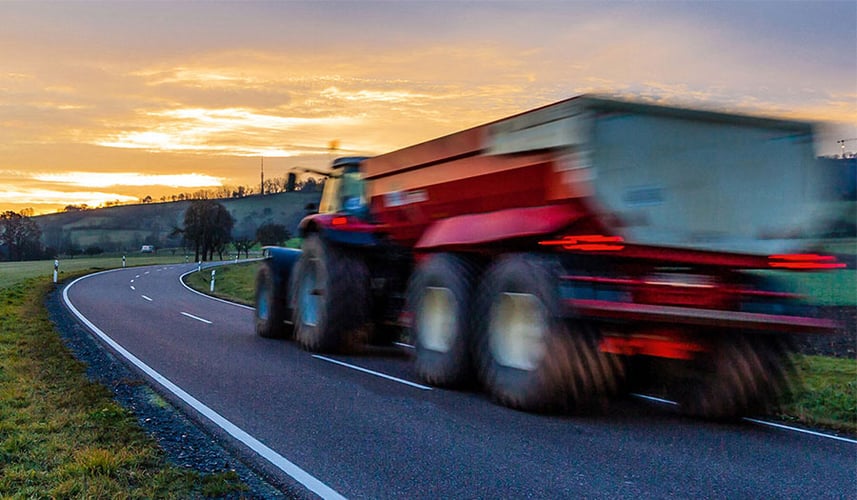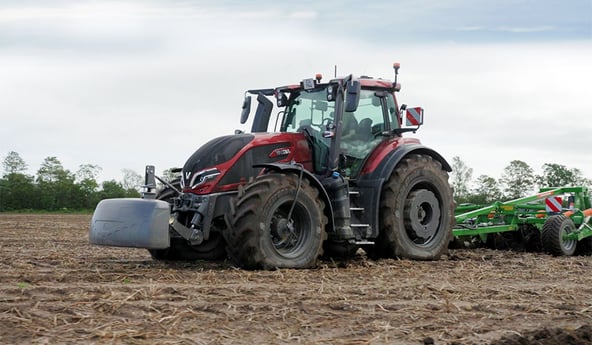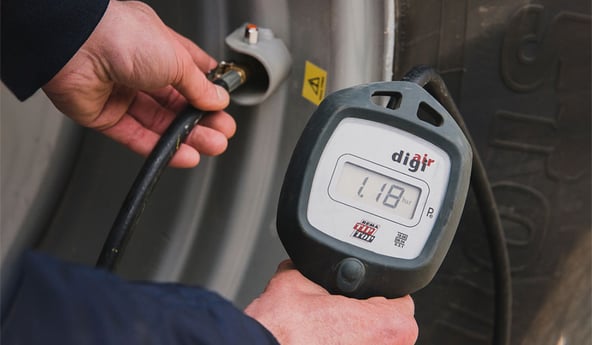Unlike a car, a tractor is a multi-purpose vehicle which can carry or pull much more than its own weight, over all types of terrain. These demands are managed by your tyres and the disparity between these demands is the reason why it is important to always have the right pressure settings, to make your equipment last over time.
Carrying out pressure adjustments may seem insignificant, but for your tractor it is a crucial adjustment which will enable you either to double the load, to preserve the soil on your land, to drive slowly with a heavier load or rapidly with no load…
In this article you will find the explanations you need to help you understand why it is important always to have the right tyre pressure.
1. What is the link between load, speed and tractor tyre pressure?
Pressure, speed and load settings are the three key elements on which the correct functioning of your tyres depends. They operate simultaneously, are interdependent and are necessary to ensure good management of the lifespan of your tyres.
Tyre pressure is an easy adjustment to understand:
- An increase in pressure allows you to carry more load but increases soil compaction.
- A decrease in tyre pressure allows you to reduce soil compaction but limits the load on each tyre.
But what really is the link between speed and load? And why are they always associated?
You can see that the tyre undergoes a major deformation at the level of the contact patch with the ground, this deformation is linked to the load which crushes the tyre, and is known as deflection.

When you drive, the deformed area progressively regains its initial shape during the rotation of the tyre. At low speed, the tyre has recovered its initial shape after one rotation and everything continues smoothly.
The higher the load, the greater the extent of the deflection, so if you increase speed on the road with a heavy load, the tyre does not have time to get its initial shape back before it comes into contact with the ground again during the next rotation. This results in the deformation getting bigger with each rotation of the wheel as well as excessive heating of the tyre components and can even result in a break in the casing.
That is why the pressure charts always show the inflation pressure that corresponds to a given load for a precise speed.
If your speed is higher than indicated in the chart, the inflation pressure for this same load will be insufficient.
2. Why inflation pressure changes depending on the load
1. Pressure compensates for load
When a tyre is completely flat, it cannot bear any weight at all. It’s the volume of air within the tyre, i.e. the pressure, which allows it to bear the weight of the tractor and your implements.
The more you increase inflation pressure, the more you increase the tyre’s capacity to withstand the load.
The limit to this load capacity is indicated on the sidewall of your tyre in the form of a number associated with a letter (the number corresponds to a load index and the letter corresponds to a speed index, generally in relation to a nominal inflation pressure of 1.6 bar).

This index shows the maximum load for a given speed, in general with a nominal inflation pressure of 1.6 bar in the usual correlation tables. See the correlation table below
2. Yes, you can exceed the load index in certain conditions
The manufacturer has tested its tyres for use with a maximum load at a given speed and a precise pressure. These are optimal conditions of use for the tyre which allow you to work safely while safeguarding your tyre’s lifespan.
Obviously, you can work with a smaller load and reduce the pressure to avoid soil compaction for example, respecting the minimum pressure recommended by the manufacturer and your driving speed.
But you can also go beyond the load index within a certain limit and on condition that you compensate using the two other settings:
- Pressure must be increased as a result
- Speed must be reduced proportionally
» EXAMPLE: for a VX-TRACTOR 900/60 R42
tyre with a load index and speed index of 185 D
| Pressure: 1.6 bar Speed: 65 km/h |
Load capacity = 9,250 kg. |
| Pressure: 2.4 bar Speed: 10 km/h |
Load capacity = 13,900 kg i.e. 50% more. |

3. Standard load index table for a pressure of 1.6 bar
The simplest solution for good tyre management still lies in respecting manufacturer recommendations.
When it comes to replacing your tyres, you should choose tyre dimensions which take account of the load corresponding to your usual implements so as to never accidentally go beyond the limit.
To find out the load index of your future tyres, you can refer to the standard load index table below with its correspondence in kilos.
This table gives you the maximum load for a pressure of 1.6 bar
Load index table and correspondence in Kg for a nominal inflation pressure of 1.6 bar
| I.C. | kg | I.C. | kg | I.C. | kg | I.C. | kg | I.C. | kg |
| 73 | 365 | 74 | 375 | 75 | 387 | 76 | 400 | 77 | 412 |
| 78 | 425 | 79 | 437 | 80 | 450 | 81 | 462 | 82 | 475 |
| 83 | 487 | 84 | 500 | 85 | 515 | 86 | 530 | 87 | 545 |
| 88 | 560 | 89 | 580 | 90 | 600 | 91 | 615 | 92 | 630 |
| 93 | 650 | 94 | 670 | 95 | 690 | 96 | 710 | 97 | 730 |
| 98 | 750 | 99 | 775 | 100 | 800 | 101 | 825 | 102 | 850 |
| 103 | 875 | 104 | 900 | 105 | 925 | 106 | 950 | 107 | 975 |
| 108 | 1 000 | 109 | 1 030 | 110 | 1060 | 111 | 1 090 | 112 | 1 120 |
| 113 | 1 150 | 114 | 1 180 | 115 | 1215 | 116 | 1 250 | 117 | 1 285 |
| 118 | 1 320 | 119 | 1 360 | 120 | 1 400 | 121 | 1 450 | 122 | 1 500 |
| 123 | 1 550 | 124 | 1 600 | 125 | 1 650 | 126 | 1 700 | 127 | 1 750 |
| 128 | 1 800 | 129 | 1 850 | 130 | 1 900 | 131 | 1 950 | 132 | 2 000 |
| 133 | 2 060 | 134 | 2 120 | 135 | 2 180 | 136 | 2 240 | 137 | 2 300 |
| 138 | 2 360 | 139 | 2 430 | 140 | 2 500 | 141 | 2 575 | 142 | 2 650 |
| 143 | 2 725 | 144 | 2 800 | 145 | 2 900 | 146 | 3 000 | 147 | 3 075 |
| 148 | 3 150 | 149 | 3 250 | 150 | 3 350 | 151 | 3 450 | 152 | 3 550 |
| 153 | 3650 | 154 | 3 750 | 155 | 3 875 | 156 | 4 000 | 157 | 4 125 |
| 158 | 4 250 | 159 | 4 375 | 160 | 4 500 | 161 | 4 625 | 162 | 4 750 |
| 163 | 4 875 | 164 | 5 000 | 165 | 5 150 | 166 | 5 300 | 167 | 5 450 |
| 168 | 5 600 | 169 | 5 800 | 170 | 6 000 | 171 | 6 150 | 172 | 6 300 |
| 173 | 6 500 | 174 | 6 700 | 175 | 6 900 | 176 | 7 100 | 177 | 7 300 |
| 178 | 7 500 | 179 | 7 750 | 180 | 8 000 | 181 | 8 250 | 182 | 8 500 |
| 183 | 8 750 | 184 | 9 000 | 185 | 9 250 | 186 | 9 500 | 187 | 9 750 |
| 188 | 10 000 | 189 | 10 300 |
3. Why take speed into account in pressure settings?
To preserve your tyre’s constituent materials and ensure a good lifespan, it is definitely best not to exceed the speed index when loaded.
With a high speed index, the tyre deforms and the internal structure heats up (up to 65° at high speed and overloaded) leading to rapid wear to the rubber in the tread.
While it is advisable to reduce pressure to avoid soil compaction in your fields, an underinflated tyre on the road will suffer many kinds of damages:
- Lifespan reduced by 25% due to the abrasiveness of the asphalt.
- Reduced stability in the bends and when braking, as underinflated sidewalls suffer from excessive deflection.
- Increased fuel consumption due to the extra-large contact patch with the ground.
- Irreversible damage to the casing linked to the collapsing of the sidewalls.
It is therefore preferable to increase pressure on the road while remaining within the limits indicated in the markings on the sidewall for which you will find the equivalent in km/h in the table below.
Speed index charts with correspondence in km/h
| Speed index | Speed (in km/h) | Speed index | Speed (in km/h) | |
| A1 | 5 | B | 50 | |
| A2 | 10 | C | 60 | |
| A3 | 15 | D | 65 | |
| A4 | 20 | E | 70 | |
| A5 | 25 | F | 80 | |
| A6 | 30 | G | 90 | |
| A7 | 35 | |||
| A8 | 40 |
Yes, you can exceed the speed index in certain conditions
As far as respecting speed is concerned, the relation to load is inevitable; if you drive with no load, exceeding the speed index will have no consequences on the structure of the tyres, on condition that you comply with applicable regulations and safety rules.
ETRTO (European Tyre and Rim Technical Organisation) has recommended adjusting pressure and load based on driving speed. At high speed, an inflation pressure higher than the load correspondence is recommended (while staying within the maximum limits recommended by the manufacturer).
Consider appropriate inflation pressure in advance if you have long distances to travel by road:
- To increase speed by more than 10 km/h
= increase pressure by 0.20 bar
As well as reducing your load:
- To increase speed by more than 10 km/h
= reduce the load by 5%

4. VF tyres: the best solution to avoid repetitive pressure adjustments
If you don’t have time to adjust the inflation pressure in your agricultural tyres when you go from field to road, your best solution is to use VF technology tyres.
VF tyres (Very Improved Flexion) provide great operating flexibility. They are made with very high-tech components, have a very supple sidewall and a more resistant structure which makes them extremely polyvalent for use on all types of land. You no longer need to adjust pressure settings between field and road.
This progress is really convenient and saves considerable time for farmers who are always in a hurry and who don’t know which pressure is best for each type of ground.
In addition to this considerable advantage, these new technologies are designed to bear higher loads. With the same inflation pressure, a VF tyre will be able to carry 40% more load than a standard tyre.
Good to know
unlike standard agricultural tyres which cannot go below 1.2 bar, VF tyres were designed to be inflated to less than 0.8 bar despite the bonus load, making them highly effective in terms of soil preservation.
The Bridgestone-agriculture.eu blog is written and administered by tractor tyre experts who are available to provide you with the advice that you need about your farming tyres. They will help you to maximise your productivity with information on all things relating to tyres: inexpensive tractor tyres - technical data for farming tyres - advice on farming tyre pressure - solution to avoid soil compaction - sprayer tyre pressure - Why and how to ballast your tractor tyres - when to use twin wheels - the mechanical causes of abnormal wear - cheap agricultural tyres - etc.
To take it a step further and increase the profitability of your farm, the tractor tyre experts has prepared a free, highly detailed, ebook which explains the essential role of farming tyres on your productivity..
Most people who read this article have also read some of the following articles:
- 12 simple tips to better manage the pressure of your agricultural tyres
- 7 advantages of low-pressure tyres compared to normal tyres
- The keys to working at very low pressure with your agricultural tyres
- Understanding your tractor tyres’ pressure -load -speed link
- Tank Air Wheel rims, to inflate tyres in 1 minute
- Can you go beyond the recommended pressure for your tractor tyres?
- Opt for a harvest campaign with low-pressure tyres
- 11 keys for knowing everything about agricultural tyre pressure
- How agricultural tyre pressure affects your efficiency
- Load transfer to agricultural tyres: from theory to practice
This information is intended only to make you aware of the technical and functional aspects of agricultural tires and their use. It does not allow you to make a judgment or a definitive conclusion on a given problem. Only your agricultural tire expert is able to make a technical assessment and take a final decision, case by case.
Leave a
commentary
Your email address will not be published.
Required fields are indicated with *








